So you want to replace a faucet. It's actually not too hard, but finding the right flexible
connector is!
There's a "3/8 Comp (Compression) to 1/2 inch IPS"
But wait. Here's another brand that says "3/8 Comp to 1/2 inch FIP"
And here's yet another brand that says "3/8 Comp to 1/2 inch FPT"
HINT: They're all the same!!
And if you know a little bit about piping, it's even more confusing, because these connectors that say "Comp" don't look like a typical Compression fitting, and you don't use a compression ferrule and nut when connecting them (image below).
Ditto with flexible toilet connectors.
There's a "3/8 Comp to 7/8 FIP (or FPT)"
Some brands might say "3/8 Comp to 7/8 Toilet Connector"
Furthermore, these will often say "3/8 Comp to 7/8 Ballcock"
"Do what??" you say! "I'm looking for a toilet connector, not an adult "novelty"! Well, let's just
say that plumbers must be an earthy lot. The toilet "fill valve" that these connectors attach to is
for whatever reason called a "ballcock", presumably because of the oval-shaped float that they used.
Need a short piece of pipe that's threaded on both ends? Plumbers call it a "nipple"!
And then there are "male" connectors vs "female" connectors.
So this article will attempt to "de-confuse" all these abbreviations - NPT, IPT, MIP, FIP, and the like. It will also present some tips on how to decide which size you need, and even some information on how to work with piping and connectors.
So, first I will discuss pipe buzzwords - or perhaps we should say buzz-acronyms.
Piping terms are based on two sets of abbreviations, one of which is fundamentally flawed:
NPS (National Pipe Straight)
NPT, which stands for either of TWO things:
National Pipe Tapered (original meaning)
National Pipe Thread (Identical in meaning to NPS!)
Somewhere along the line, these specifications were adopted internationally. Hence:
IPS (International Pipe Straight, sometimes "Iron Pipe Straight")
IPT (International Pipe Thread (or Tapered), sometimes "Iron pipe Thread/Tapered")
Further, to distinguish between "male" and "female" pipe fittings, the following two sets of abbreviations were adopted:
FPT (Female Pipe Thread)
or FIP, (Female International Pipe, or Female Iron Pipe)
MPT (Male Pipe Thread)
or MIP, (Male International Pipe, or Male Iron Pipe)
NOTE: The terms Male/Female Iron Pipe are historical, since plain iron pipe is no longer used.
Thus one can summarize the terms you will likely see for the SAME connector or fitting:
IPS = FPT = FIP
for FEMALE connectors or fittings.
IPS = MPT = MIP
for MALE connectors or fittings.
NOTE: All these acronyms are loosely used (due to the historical issue between "Thread" and "Tapered").
Thus these sets of terms sometimes are used for straight pipe threads - in which case they really are "IPS" -
and other times for tapered pipe threads - in which case they are not really "IPS"!! (IPT, for
whatever reason, is not commonly used.)
So for example, the SAME faucet connector may be (depending on the manufacturer) named:
"3/8 inch Comp by 1/2 inch IPS"
"3/8 inch Comp by 1/2 inch FIP"
"3/8 inch Comp by 1/2 inch FPT"
And that, my friends, is why it is SO DIFFICULT to find the correct connector or fitting for your project!!
So. . . what is meant by "Straight" vs "Tapered" in piping? |
||
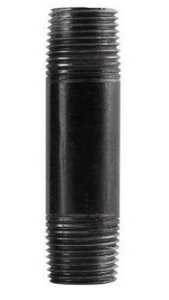 |
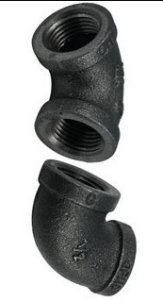 |
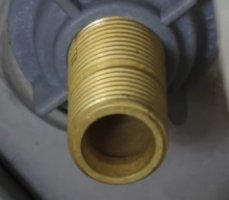 |
Shown here is a short gas pipe, a "nipple" in plumbing parlance. This is the original
type of "pipe", used for years for gas and even water lines. Today it is used mainly for natural gas or propane.
It has two "male" ends, and you can see the slight taper on these ends. |
Here are two "90 degree elbows". Their connections are "female". The internal
threads are also tapered, and will accept the tapered male connector, but only to a certain depth, due to
the taper. |
And here is the connection fitting underneath a typical faucet. It has no taper,
and neither does the typical flexible water line that is used to attach to it. |
Want some tips on working with pipe? At the end of this article, I discuss the various pipe compounds and teflon tapes, and when to use them. |
||
Faucet Connectors
This section will discuss flexible connectors for faucets, along with the typical water shutoff valve that is used to make faucet replacement safer and more convenient - you don't have to shut off the entire home water supply to replace a faucet.
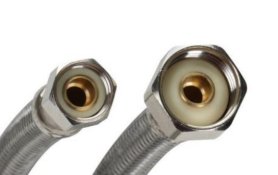 |
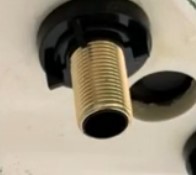 |
The most common faucet flexible supply line. |
And here is a typical faucet 1/2 inch straight pipe fitting. Some faucets have a
ridgid line that extends out several inches, and has a threaded section at the end as a fitting. You connect
the 1/2 inch side of the flexible line to this fitting. |
Determining what size your existing
supply line is: If a 5/8 wrench fits the nut, it's a 3/8 inch Comp. If a 3/4 wrench fits the nut, it's a 1/2 inch Comp. NOTE: Plumbing lines and fittings are SLOPPY! They do not seem to be held to the tolerances of normal bolts, nuts, and other fasteners. So you might find that wrenches will not quite fit at all, or even find that they fit only some sides of the nut! You can try metric wrenches, or in many cases, it's the adjustable wrench for you. If you're a mechanic or engineer, just suck it up! |
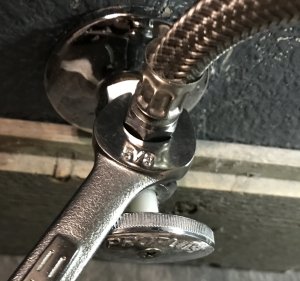 |
Side Comment: Why is it called a "3/8 Comp (Compression)"
when it really isn't? |
||
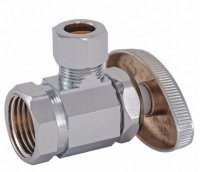 |
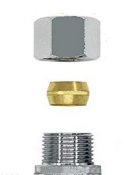 |
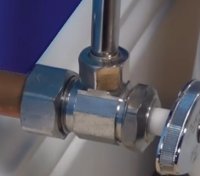 |
Here is a typical water stop valve. It is installed when your house is built. The top part is the "3/8 Compression" outlet. |
Here is an expanded view of the nut and the compression ferrule that are contained within the outlet (when it is new). |
The ferrule and nut are intended to be used with straight copper (or chrome plated)
pipe, which is what used to be used to go to the faucet (top pipe in this image). But somewhere in the 90s,
flexible supply lines came to be used instead of the rigid copper pipe. |
Toilet Connectors
This section will discuss flexible connectors for toilets.
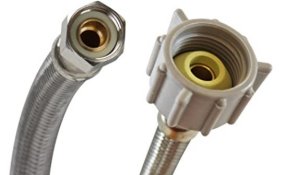 |
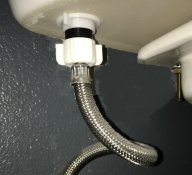 |
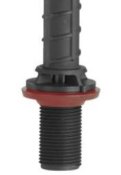 |
The most common toilet flexible supply line. |
The 7/8 FPT/FIP connection to the toilet fill valve, or in plumber's parlance, the "ballcock". |
Here is the bare male connection on the bottom of a Fluidmaster toilet fill
valve. It is a 7/8 inch IPS, because it is "straight" and not tapered. |
Determining what size your existing
supply line is: If a 5/8 wrench fits the nut, it's a 3/8 inch Comp. If a 3/4 wrench fits the nut, it's a 7/16 inch Comp. If a 7/8 wrench fits the nut, it's a 1/2 inch Comp. |
||
Water Heater Water Supply Connectors
This section will discuss the two water line flexible connections (Hot and Cold)
 |
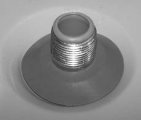 |
The most common water heater flexible water supply line. |
Water heaters usually have connection pipes on the top, referred to as "nipples". These are male and usually have tapered threads, hence they are "MIP" connections. |
Determining what size your existing
supply line is: |
|
Flexible Gas Supply Lines
This section will discuss the flexible gas lines for Natural Gas or Propane heaters.
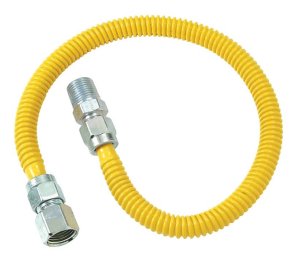 |
The most common water heater flexible gas supply line. Male connector by Male connector. ("1/2 inch MIP by 1/2 inch MIP, 1/2 inch gas") Male connector by Female connector. ("1/2 inch MIP by 1/2 inch FIP, 1/2 inch gas") Female connector by Female connector. ("1/2 inch FIP by 1/2 inch FIP, 1/2 inch gas") (Yep, these might say "MPT" or "FPT" in place of "MIP" or "FIP".) |
Determining what size your existing supply line is (1/2 inch is the most common for gas water heaters): If a 7/8 wrench fits the connection nut, it's a 1/2 inch gas line. If a 1 in wrench fits the nut, it's a 5/8 inch gas line. |
|
So. . . we listed the three types for flexible gas lines in the paragraph above. |
||
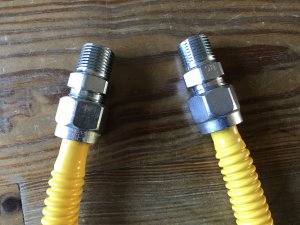 |
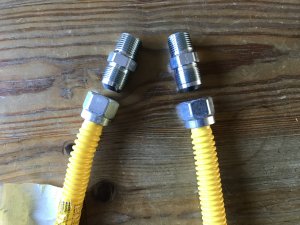 |
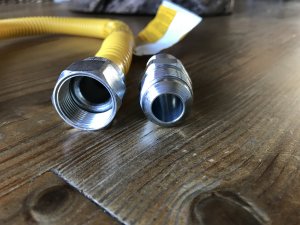 |
This particular flexible line had "MIP" adapters on each end. |
The connectors are unscrewed from the new line and attached to the existing supply lines and/or the water heater inlet itself, usually with some sort of pipe compound (see "How to Connect Pipes and Lines" below). |
On the left side you can see that the gas line itself has been flared.
(It can be seen deep inside the connecting nut.) Its adapter on the right has a chamfered smooth end
that the flare will squeeze against. |
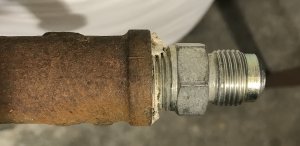 |
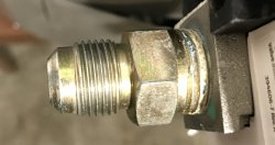 |
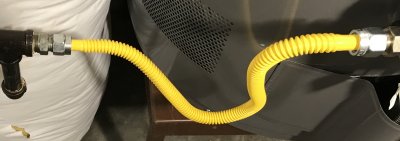 |
Here is the (rusty) end of my existing iron pipe gas line. The "gas pipe" side of the adaptor screws into the existing gas pipe. However, this is the existing adaptor! I was not able to remove the existing one (too tight!) So I lightly sanded the chamfered surface with very fine sandpaper and cleaned it thououghly. |
On the right side, a new adaptor was attached to the water heater inlet. |
So here's the installed gas line. The short iron pipe on the left - pointing downward -
is a "sediment trap". The right side, as shown in the adjacent image, is connected directly to the water
heater inlet. |
How to Connect Pipes and Lines
In connecting the various types of pipe, pipe compounds and/or teflon tapes are
necessary (in some cases) to provide lubrication while tightening the pipes and to prevent leaks.
But there are exceptions.
It is always recommended to replace all flexible lines when servicing plumbing or gas items.
(It may actually even be required in some areas.) Why? For water supply lines, the existing rubber
or plastic washers are usually dried out and/or deformed. For gas supply lines, existing flares have been
partially crushed at the time of the prior installation.
Connecting tapered piping like "nipples", tees, and 90 degree elbows? Then use pipe compounds or teflon tape. White teflon tape for water, yellow teflon tape for natural gas or propane.
Connecting flared lines? Then no compounds or tape. (You want to be able to remove the flexible line later.) It might be helpful, however, to apply a small amount of WD-40 or similiar light oil to the threads. As a former auto mechanic, I prefer to avoid putting up metal-to-metal threads dry, whether it be fittings, connections, or even nuts and bolts.
Connecting water supply lines for faucets and toilets? Usually no compounds or tapes, since the rubber or plastic washers do the sealing (and you want to be able to remove the lines later). But it might be good practice to use teflon tape for the big 3/4 inch water supply lines for water heaters. Also, tighten faucet and toilet lines gently - don't overtighten.
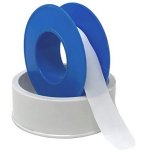 |
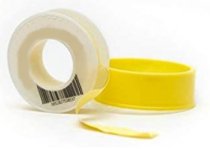 |
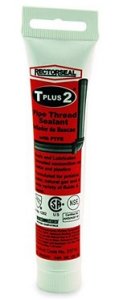 |
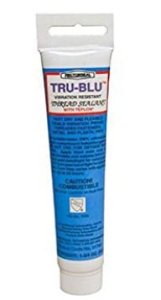 |
|
White teflon tape: This is the lightest duty material used for sealing pipe joints. It should
not be necessary for connecting flexible faucet/toilet lines to the water shutoff valve, since the rubber or plastic
washer does the sealing. But it might be good for the other end of faucet lines (which connect to the male threads
extending down from the faucet). Another application might the 3/4 inch water flex lines for water heaters.
Even though all these lines have a rubber washer, it might help to use the white tape. It helps lubricate the threads
for easier tightening. Another good application would be replacing a shower head. Yellow teflon tape. It's used for gas lines, and is thicker and more rubbery than the white tape. Usually pipe compounds are used instead. But you could consider using the yellow tape if you anticipate disconnecting the pipes in the near future. Rectorseal "T Plus 2". This is a thick white colored material. Brush this on the male threads, but wipe off the end to prevent the compound from getting inside the lines. The Rectorseal catalog lists this product as "non-setting", which may help in future disassembly. Rectorseal "Tru-Blu". This is a thinner blue colored material. Use the same way as the T Plus 2. The Rectorseal catalog lists this as "Fast drying - flexible set". It is thus indicated for joints that may be subject to vibration. Note that there are certainly lots of other brands of pipe compounds. . . |
|||
Copyright © 2020 J.A.